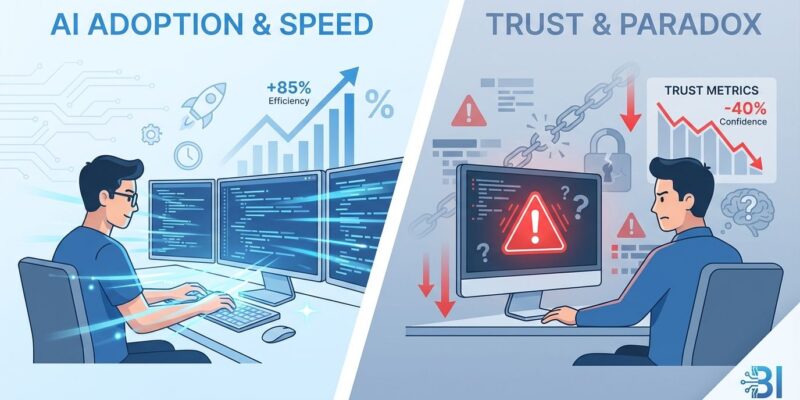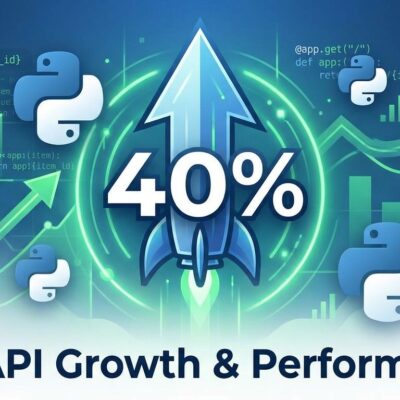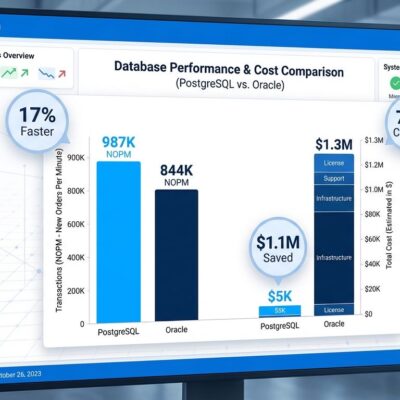
Eighty-five percent of developers have adopted AI coding tools, with one in five saving a full workday—eight hours or more—every week, according to major 2025 surveys from Stack Overflow and JetBrains. However, here’s the contradiction defining this year’s developer experience: only 33% trust the accuracy of these tools they’re using daily, down from over 70% just two years ago. The industry’s biggest productivity story is actually its biggest trust crisis.
This isn’t resistance to new technology. These are 73,000 developers across two comprehensive surveys—Stack Overflow’s 49,000 respondents and JetBrains’ 24,534—actively using AI tools while simultaneously losing confidence because of that experience. Moreover, trust is cratering during mass adoption, not before it.
The Perception Gap: Feeling Fast While Slowing Down
The time savings are real. Nearly 9 out of 10 developers save at least an hour every week, and 20% reclaim a full workday, according to JetBrains’ State of Developer Ecosystem 2025. However, a study by METR this year found something unsettling: developers using AI tools like Claude 3.5 Sonnet were actually 19% slower on real-world tasks—despite feeling 20% faster.
The 16 experienced programmers in METR’s study completed 246 tasks on large, established open-source projects. The pattern was consistent: perceived productivity gains that didn’t materialize in actual completion times. Consequently, time “saved” generating code gets consumed reviewing, debugging, and fixing the output.
Stack Overflow’s data supports this. Sixty-six percent of developers cite “AI solutions that are almost right, but not quite” as their primary frustration. Furthermore, forty-five percent report that debugging AI-generated code takes more time than writing it themselves. This is productivity theater—tools optimized for code generation velocity while developers need reliability and maintainability.
Trust Collapsing at 10 Points Per Year
The trust trajectory is stark. Developer confidence in AI accuracy dropped from over 70% in 2023-2024 to just 33% in 2025, according to Stack Overflow’s survey results. Meanwhile, forty-six percent now actively distrust AI tools, and only 3% report “highly trusting” the output. Experienced developers show the lowest trust: just 2.5% highly trust AI, while 20.7% express high distrust.
The pattern matters more than the numbers. Positive sentiment declined from 70%+ to 60% in a single year. Therefore, if this trajectory continues—trust dropping roughly 10 percentage points annually—we’re looking at a correction point where adoption either reverses or the industry accepts significantly lower quality standards.
Developers are voting with their behavior even as they use these tools daily. Seventy-five percent prefer consulting human colleagues when AI answers are uncertain. Additionally, thirty-five percent of Stack Overflow visits now stem from AI-related issues—developers actively seeking human-validated answers to verify machine output. The tools are ubiquitous, but so is the skepticism.
The Hidden Costs Compound
Those eight-hour weekly “savings” come with a price tag that doesn’t show up in productivity dashboards. Features built with more than 60% AI assistance take 3.4 times longer to modify six months later, research shows. Moreover, AI adoption is linked to 9% more bugs per developer and a 154% increase in average pull request size.
The code quality issues run deeper than inconvenience. Research from Apiiro found AI-generated code introduces 322% more privilege escalation paths and 153% more design flaws compared to human-written code. Furthermore, forty percent of AI-generated code contains vulnerabilities—Python snippets show a 29.5% weakness rate, JavaScript 24.2%. GitHub repositories with Copilot enabled leak secrets at 6.4%, versus 4.6% for standard repos.
This is why experienced developers show the lowest trust. They’ve seen technical debt compound before, and AI-generated debt is especially insidious. The “almost right” code passes initial tests, ships to production, and creates subtle bugs that surface weeks or months later. Consequently, the initial velocity boost becomes a maintenance nightmare.
Trapped Between Pressure and Reality
Developers face a squeeze. Sixty-eight percent expect employers to require AI proficiency soon, but 46% actively distrust these same tools. As a result, they’re locked into using technology they don’t trust to remain competitive—a career calculus that creates cognitive load and organizational dysfunction.
The community backlash reflects this tension. GitHub users have been vocal about Copilot’s quality deterioration in 2025, with complaints describing the tool as “hallucinatory, complicating, wrong, sycophantic, forgetful.” When GitHub introduced AI-generated issues in May, developers immediately requested the ability to block Copilot-generated content from their repositories. Meanwhile, some are migrating to alternative platforms like Codeberg or self-hosted Forgejo specifically to escape forced AI integration.
Only 16.3% of developers in Stack Overflow’s survey said AI made them “more productive to a great extent.” The largest group—41.4%—reported AI had “little or no effect” on their productivity. The disconnect is clear: leadership measures output (lines of code, tickets closed, PR velocity), while engineers measure outcome (reliability, maintainability, correctness). One group sees productivity gains, the other sees quality degradation.
What Developers Actually Value
When endorsing new technology, developers rank “reputation for quality” and “robust and complete API” far above “AI integration”—which placed second-to-last in Stack Overflow’s survey. In other words, they want trustworthy solutions, not trendy ones. The tools they’re being pushed to adopt optimize for adoption metrics and engagement while developers need accuracy and reliability.
The experience gap tells the story. Junior developers see 21-40% productivity gains on routine tasks. In contrast, senior developers see 7-16% improvements with diminishing returns on complex architectural work. AI excels at scaffolding and boilerplate generation but struggles with the nuanced problem-solving that defines senior engineering work. Therefore, the more experienced you are, the less useful—and more frustrating—these tools become.
Teams with high AI adoption interact with 47% more pull requests per day, according to analysis by Faros AI. The tools generate code quickly, allowing developers to scaffold multiple tasks simultaneously. However, context switching has costs. Most teams hit a productivity plateau after 6-8 months, with initial gains leveling off or reversing as technical debt accumulates.
The Productivity Bubble Question
We’re in a productivity bubble where AI generates code faster but creates hidden costs in review time, debugging, technical debt, and long-term maintainability. The eight-hour weekly “savings” are real, but so is the 19% actual slowdown. In essence, the industry is celebrating velocity while quality metrics deteriorate.
This trajectory is unsustainable. Adoption can’t continue indefinitely while trust collapses at 10 percentage points per year. Either the tools improve dramatically enough to recover developer confidence, quality issues accumulate until adoption reverses, or the industry accepts lower standards. Current trends suggest the third option: normalized expectations for “good enough” AI code rather than dramatic tool improvements.
The honest conversation the industry needs isn’t about whether to use AI tools—85% adoption settles that question. Instead, it’s about acknowledging the gap between perceived productivity and actual value, measuring the right metrics, and respecting that trust matters more than speed when you’re building software people depend on. Developers aren’t resisting the future; they’re reporting what they’re experiencing. The data backs them up.











